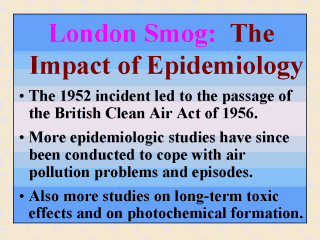| front |1 |2 |3 |4 |5 |6 |7 |8 |9 |10 |11 |12 |13 |14 |15 |16 |17 |18 |19 |20 |21 |review |
 |
The London smog
of 1952 shortly prompted the British government to introduce the Clean Air Act of 1956,
which permitted local authorities in Greater London to designate areas within which only
smokeless fuels could be burned. Initially most studies on adverse health effects of air pollution had a focus on short-term changes in incidence associated with places where coal had been widely used for domestic heating and industrial purposes. According to Maynard and Waller (1991), epidemiologic studies (e.g., Martin and Bradley, 1960) subsequent to those for the London smog of 1952 continued to show a fair correlation between smaller increases in daily deaths in Greater London and more modest episodes of high pollution like smoke and sulfur dioxide. Further epidemiologic studies related to major air pollution episodes were summarized in Maynard and Waller (1991), Costa and Amdur (1996), and Elsom (1996). Since the conduct of these acute epidemiologic studies, especially those on the 1952 incident, chronic effects of the major air pollutants have become an equally important subject matter to inhalation toxicologists. This series of acute epidemiologic and chronic toxicologic studies eventually led to a better understanding of the formation of photochemical (summer) smog. Summer smogs are major air pollution problems currently encountered by many traffic-congested megacities like Los Angles, Mexico City, and London. |